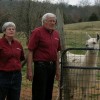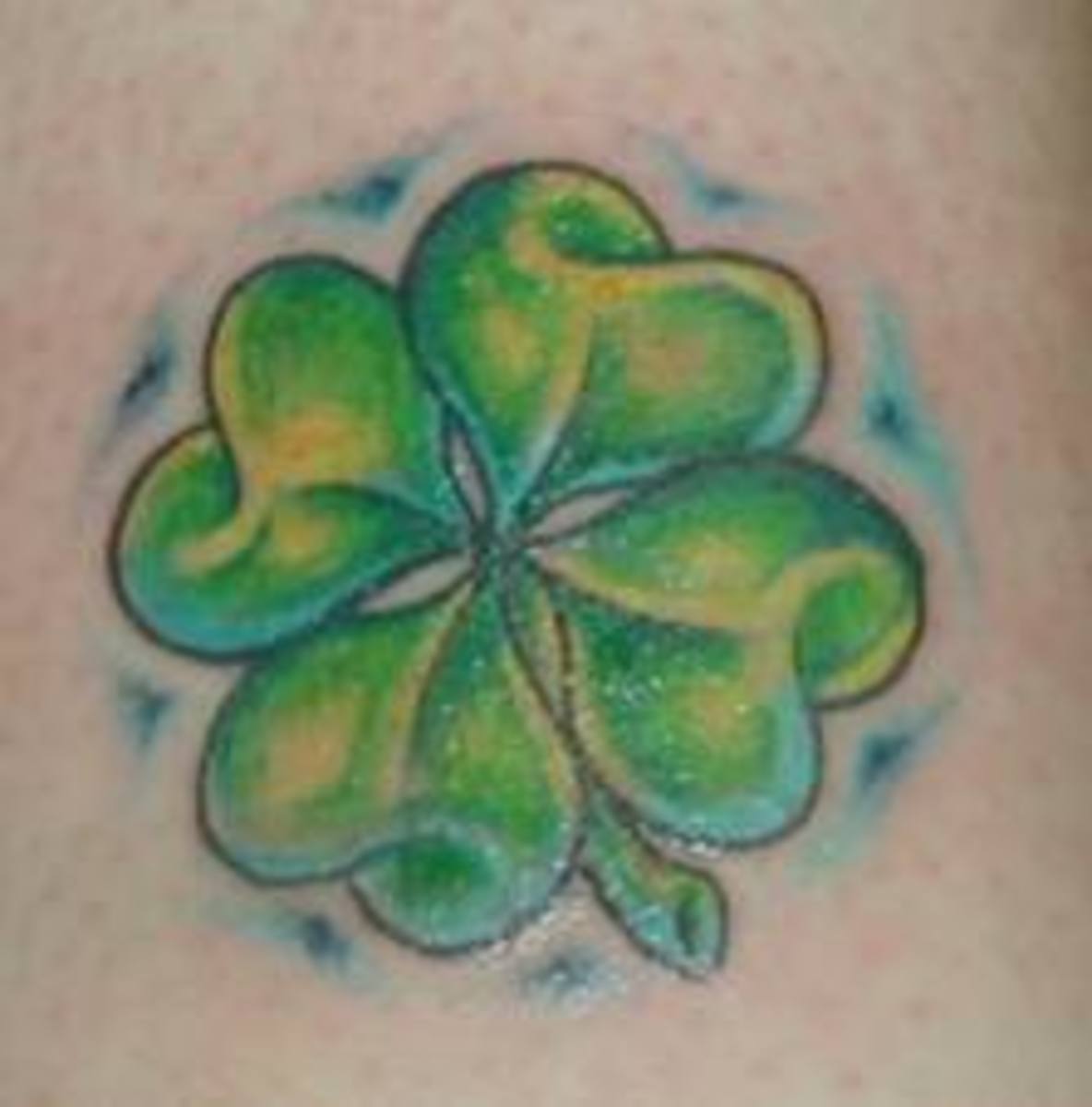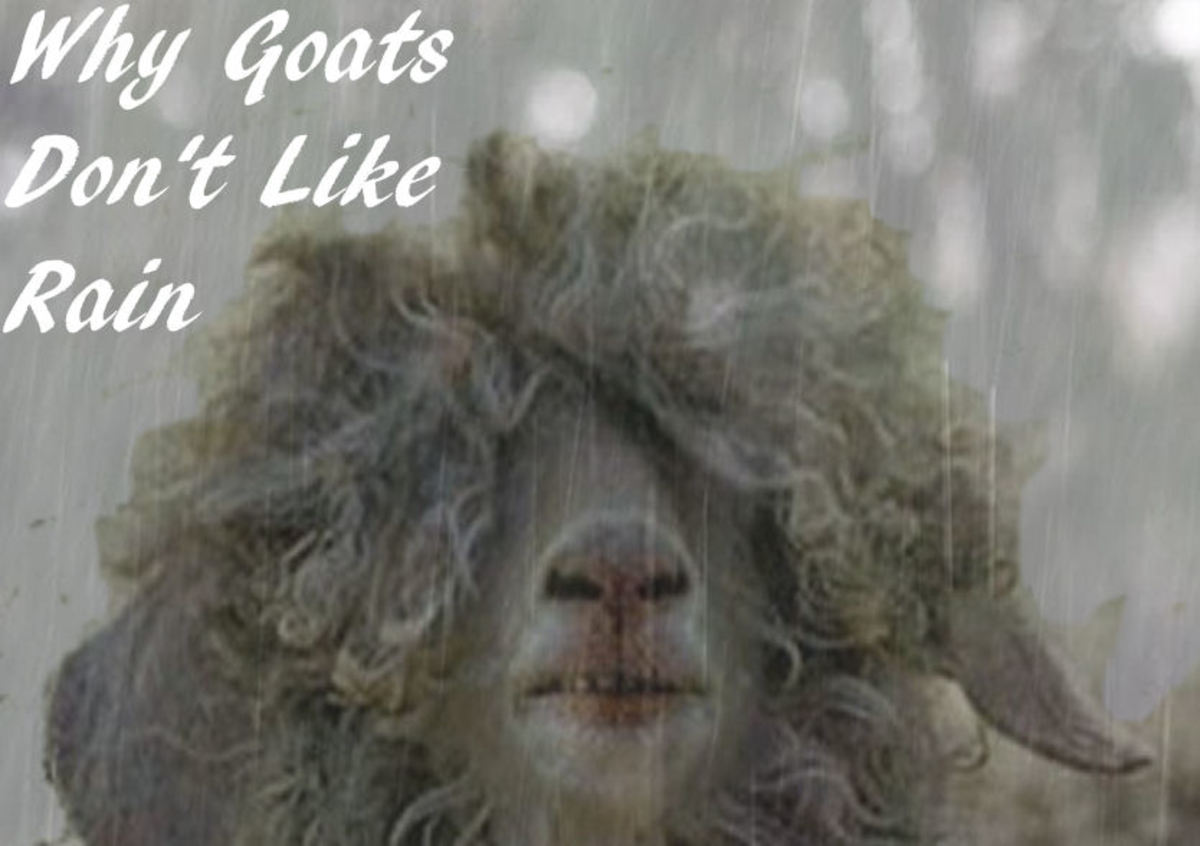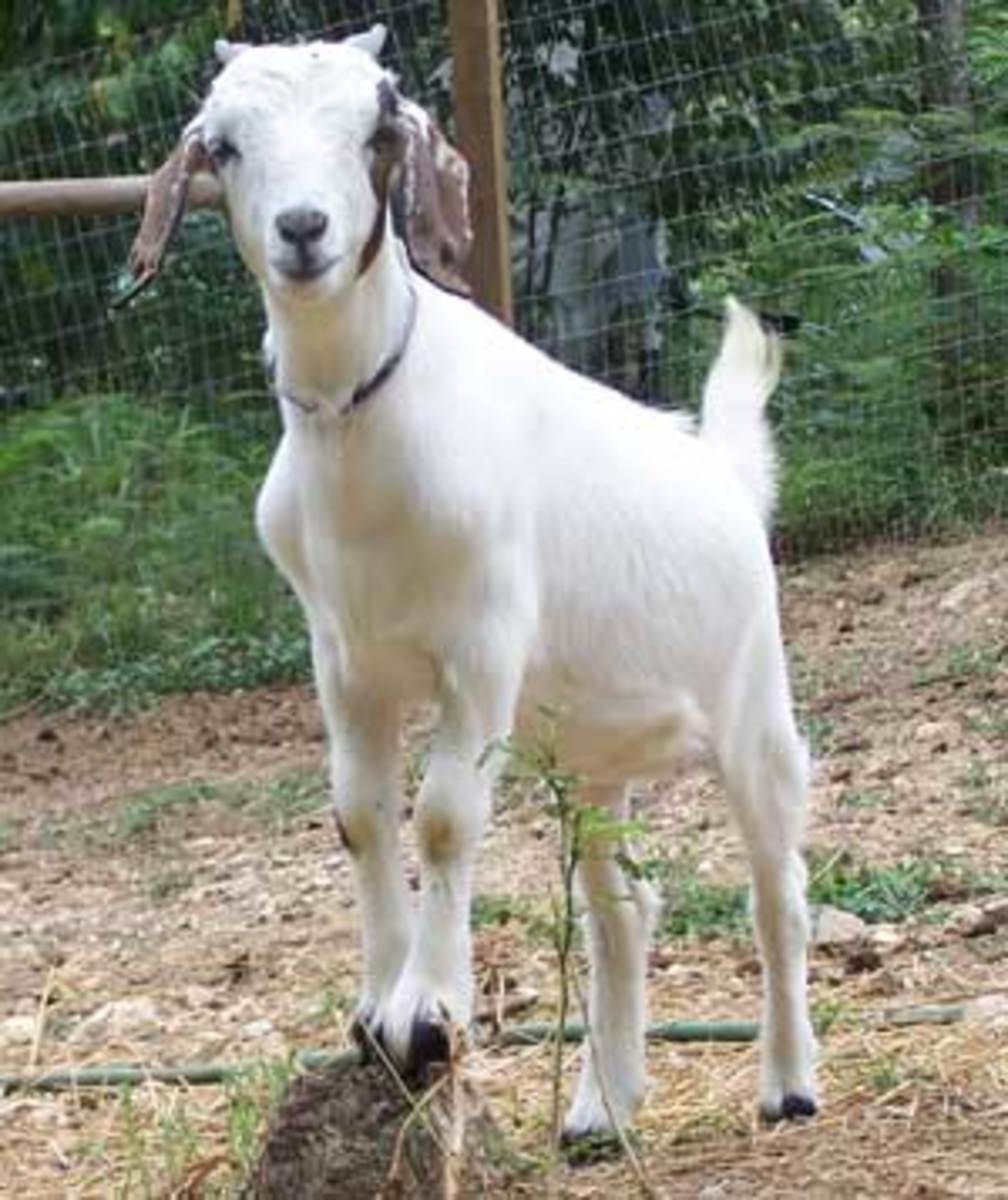Forages for Meat Goats
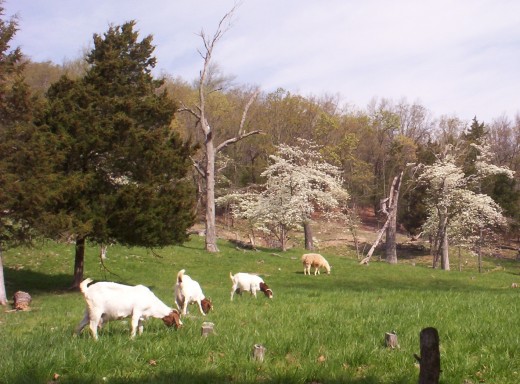
Tall Fescue
Tall fescue is very hardy. It can tolerate heavy grazing. In northern Arkansas it produces more winter grazing than any other grass. Fescue toxicity, caused by a fungus (entophyte) which infects the fescue, can result in poor condition and health problems in goats. Goats and cattle react very differently to fescue toxicity. With cattle it is a problem during hot summer weather. Since goats will not eat toxic fescue when there is anything else for them to eat, fescue toxicity is a bigger problem for goats in the winter when fescue is the only forage available for them to eat. In the winter fescue uses sugar as anti-antifreeze making it very palatable for goats. Most of the fescue growing in northern Arkansas is Kentucky 31 which has the toxic fungus. There are varieties of fescue that are entophyte free, but these varieties are not hardy and do not produce well. New varieties of fescue, called novel entophyte fescue, have an entophyte that is nontoxic. These varieties are very hardy and produce very well in northern Arkansas. Max-Q was the first novel entophyte fescue for which seed was available. All of our pastures have Max-Q fescue and we like it very well. We believe it is the hardiest most productive grass one can grow in this area, and our goats do very well on it. This variety is patented, and the seed is marketed by Pennington seed. The seed is very expensive, but it is worth the extra money. Once established, Max Q fescue is permanent. It will save money on purchased feed for many years. It will also make money through improved animal health and increased production. The fungus is only spread through the seed. When the fescue has seed on it do not let your goats travel between fields that have toxic fescue and fields that have non-toxic fescue. Do not feed any hay that has toxic fescue seed in it. If the goats eat any contaminated fescue seed, the toxic fungus can pass through their digestive tracts and infect clean fields.
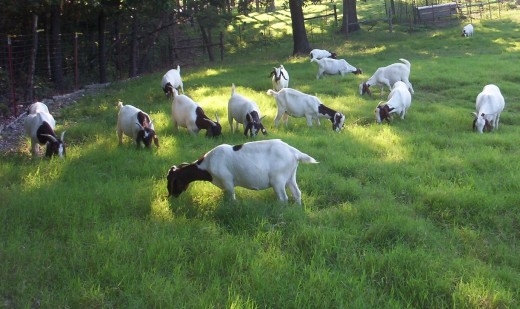
Bermuda Grass
Bermuda grass is the hardiest and most productive warm season grass for northern Arkansas. We try to keep about one fourth of our pasture in Bermuda grass. It is best used on steep, south slopes where fescue does not do well. Bermuda grass must be kept short, or the goats will not eat it. Fall rain usually brings on new growth of Bermuda grass which is freeze dried into standing hay by the first frost. Goats will eat this standing Bermuda hay in winter. We prefer common Bermuda that has been growing in our area for many years. The newer varieties will out yield common only if they are heavily fertilized and the weather is ideal. Fertilization can do more harm than good during dry weather. Bermuda grass is very easy to establish by planting sprigs or small plugs of sod. Sprigs are stems and roots dug up with a tiller. They can be planted with a sprigging machine, or they can be spread on the surface and worked into the soil with a disk. Bermuda stems will grow roots if partially buried. Bermuda spreads rapidly by growing long stems horizontally along the surface of the soil. These horizontal stems grow roots along their entire length.
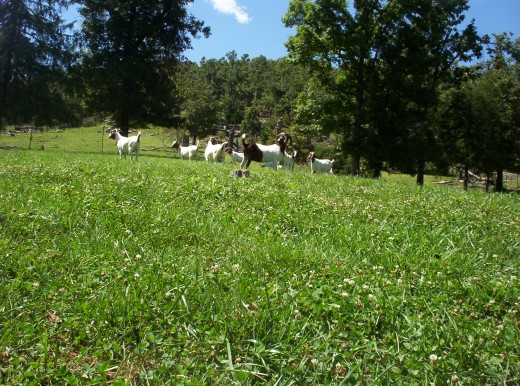
White Clover
White clover is a cool season legume. Bacteria, which grow in nodules on the roots of legumes, can fix nitrogen from the air into forms that plants can utilize to produce protein. Thus legumes are high in protein as are grasses that grow with them. Pastures and hay fields with legumes will produce more forage and will produce better quality forage because of the extra nitrogen made available by nitrogen fixing bacteria. For forty years we had over-seeded our pastures with ladino or regal varieties of white clover. We have had to do this every 2 to 3 years because regal and ladino white clover do not last very long in our climate. Six years ago we tried a new variety of white clover called durana. It is much more persistent than regal or ladino and does not go dormant during the hot summer months if plenty of moisture is available. The durana clover had gotten thicker and produced better each year since we first planted it. It also did well on poor or acid soils where regal and ladino will not grow. It grew well when over-seeded on Bermuda grass. Durana white clover also produced better than regal or ladino in the winter. Unfortunately, the durana white clover did not survive the severe droughts we had in 2011 and 2012, but it is slowly coming back from hard seed. Durana white clover is patented and marketed by Pennington seed. In the future we plan to use subterranean clover instead of white clover for our cool season legume.
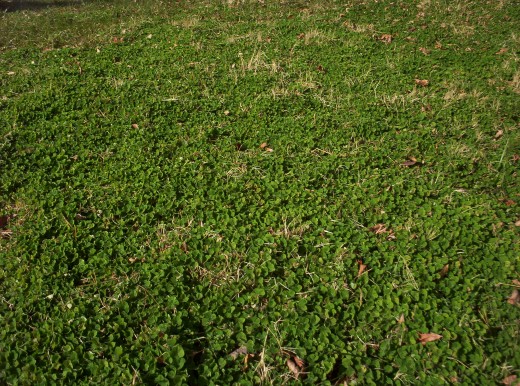
Subterranean Clover
Subterranean clover or sub clover is an annual, winter clover that comes up from seed with the autumn rains and dies in mid-June after having buried its seeds in pods like peanuts. It originated in the Mediterranean region and is widely used as a pasture legume in Australia, north western California, and western Oregon. It is adapted to climates with mild, wet winters and hot, dry summers. In northern Arkansas the autumn rains can begin any time from late August to late December depending on the year. Our climate varies a lot from year to year. Some of our autumns are very wet and others are very dry. Some of our winters are very cold and others are very mild. The University of Aransas Extension service claims that subterranean clover is not suited for northern Arkansas.
A plot of subterranean clover is located on our farm in north, central Arkansas, about twenty-five miles south of the Missouri border. We purchased this farm in 1967 from Floyd and Edna Kuhns, who had only owned it for two years. The Kuhns' had farmed in Oregon before moving to Arkansas. They thought that subterranean clover would be a good winter-forage for their livestock. They could not find seed in Arkansas so they had some seed shipped in from Oregon. They planted five acres of sub clover in the fall of 1966. They had a good stand of it when we first saw it in December of 1966. We took possession of the farm in August of 1967. In the autumn of 1967 only scattered plants of subterranean clover came up from seed. One of those plants proved to be very hardy, reseeding it’s self every year since then. It gradually spread. After forty eight years, plants from this one plant now cover an area of about one half acre. This one plant must have been a mutation that is hardier than other subterranean clovers.
In northern Arkansas this strain of subterranean clover is one of the few legumes that will persist in heavily grazed goat pastures without being reseeded from time to time. Hop clover will also persist, but it has a very short grazing season (less than 60 days.)
Sub clover does best with heavy grazing. It likes acid soils. It does best on soils with a pH of 5.5 to 6.5, but can tolerate a pH as low as 4.5. It grows six to eight inches tall. It sends out lateral branches up to four feet from a single taproot. These branches stay near the ground. They do not form roots, but they do bury seed pods. The flowers are hidden near the ground. They are self-pollinated. After pollination they grow down. The seeds are formed in pods just below the soil surface.
Subterranean clover is good at suppressing weeds and grows better than other legumes in dense Bermuda sod. All of the sub clover on our farm is growing in Bermuda sod.
Subterranean clover is more tolerant of shade than other legumes. This plus the fact that it grows close to the ground, forming a very dense mass of stems and leaves, makes it good for preventing soil erosion. In California and Oregon it is used as living mulch for orchards, vineyards, and crops such as lettuce, broccoli, cauliflower, cabbage, sweet corn, zucchini, pumpkins, cucumbers, and cantaloupes. It dies and becomes a dead mulch at a time of the year when more moisture is needed by these crops.
Phytoestrogens, in some varieties of sub clover, can cause infertility in sheep. This is not a problem with cattle or goats. Most varieties, imported into the United States, are low in phytoestrogens.
There are many new varieties of subterranean clover. Most of them have been developed in Australia. Most of the research done on sub clover was done in Australia. The University of California has published a complete review of the literature available on subterranean clover. This review can be found in their on line cover crop database.
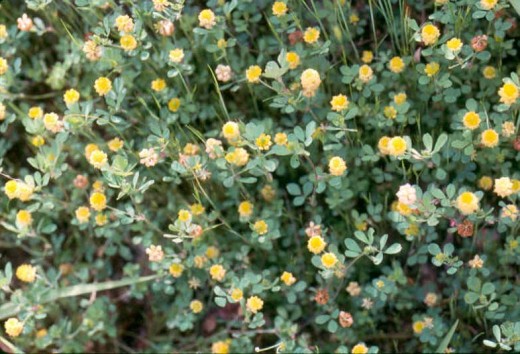
Hop Clover
Hop clover is a very hardy, annual, cool season, legume that germinates in winter, but remains very tiny (about one eight of an inch tall) and provides no grazing until April. In April and May the plants will grow to a height of six to twelve inches if not grazed. Hop clover usually dies in mid- June. It can be found growing wild in pastures, lawns, and road sides throughout the region. Seed is not available commercially, but hop clover can easily be established by spreading clippings from a lawn that has hop clover that has gone to seed. Goats will spread the seed in their droppings. Hop clover will always be thickest along paths that the goats travel and in areas that the goats bed down. It has small bright yellow flowers that turn very pale yellow then brown as the seed matures. The flower heads are shaped like those of white clover, but they are much smaller. This clover will produce flowers and seed continuously from mid-April till mid-June. It will produce an abundance of flowers and seed even if livestock keep it grazed close to the ground.
Goats love hop clover and will graze it in preference to other grasses and clovers. Based on observation, we believe that hop clover has a worming effect on both goats and cattle. To date, no scientific data is available to confirm this. One reason why hop clover continues to be an effective wormer is because it has such a short grazing season. Worms tend to build a resistance to wormers that are available for long periods of time. Goats will also produce more milk on hop clover than on other grasses and clovers. We breed our goats to kid in mid-March so they will have hop clover when their milk production is highest during the second and third months of lactation. Because goats prefer it to other grasses and clovers, hop clover gives the cool season forages, such as fescue, white clover, and subterranean clover, a chance to rest and produce seed after being grazed heavily in winter.
We have tried red clover, crimson clover, arrow leaf clover, crown vetch, and alsike clover in our goat pastures. We found that they are not as persistant as hop clover, subterranean clover, and white clover in goat pastures.
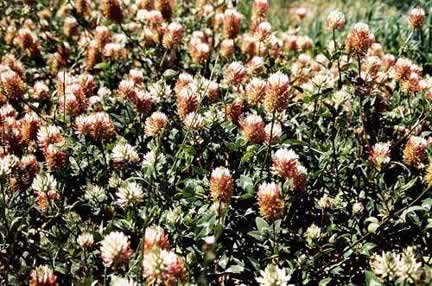
Arrow Leaf Clover
Arrow leaf clover is an annual legume that gets about three feet tall in spring and summer. It germinates in winter, and it looks like white clover in winter. In April it begins to grow tall and develop the arrow shaped leafs. It has a large flower head with green buds at the tip, then white flowers, then reddish purple flowers, then seed pods with brown flowers attached.
Arrow leaf clover produces mostly hard seed. If allowed to go to seed very little will come up the next year. Seed purchased from a seed dealer will have been scarified to enable most of it to germinate shortly after planting. To establish a stand of arrow leaf clover that reseeds itself every year, one may have to reseed it, until it accumulates enough hard seed in the ground to produce a good stand without reseeding.
We have a three quarter acre pasture that hadn’t had any goats in it for about twenty years prior to the year 2000. It had a good stand of arrow leaf clover when we put goats in it in 2000. We had goats in this pasture continuously from 2000 to January 2013. All this time we saw no arrow leaf cover in this field. In spring of 2013 we got an excellent stand of arrow leaf clover from hard seed that had been in the ground for at least thirteen years.
Arrow leaf clover seed can be planted by goats in their droppings. In 1970 we seeded ten acres of arrow leaf clover about one quarter mile from a one acre holding pen at our barn. These ten acres had a good stand of arrow leaf clover. It was the only arrow leaf clover we had ever seeded. We had about two hundred dairy goats at the time. They were allowed to graze sixty acres of good pasture that included the ten acres of arrow leaf clover by day. At night they were kept in the one acre holding pen to protect them from predators. After the goats were moved to the other end of our farm in the late 1970’s, arrow leaf clover had started coming up real thick in the one acre holding area. Since then it has spread to an area of about ten acres (including the three quarter acre field mentioned above.) The original ten acres that was seeded in 1970 no longer has any arrow leaf clover on it.
Because of its upright growth, arrow leaf clover makes excellent hay. We recommend planting it in fields that are grazed in fall and winter and used for hay in spring and summer. Arrow leaf clover does not survive in pastures that are grazed continuously.
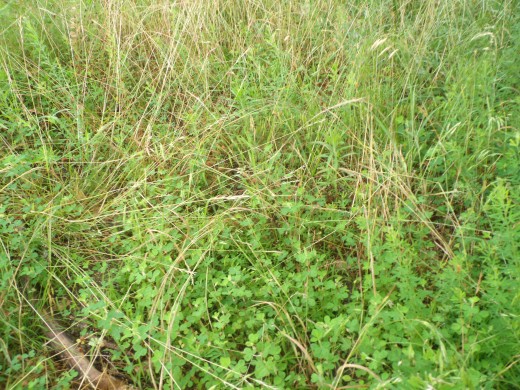
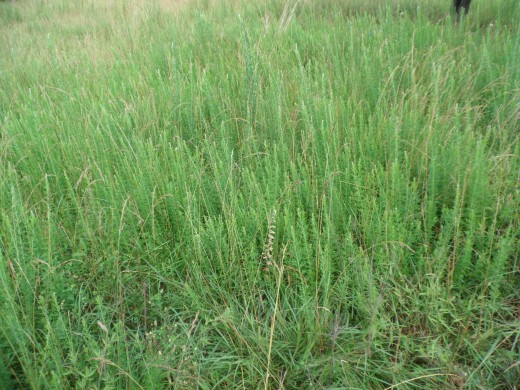
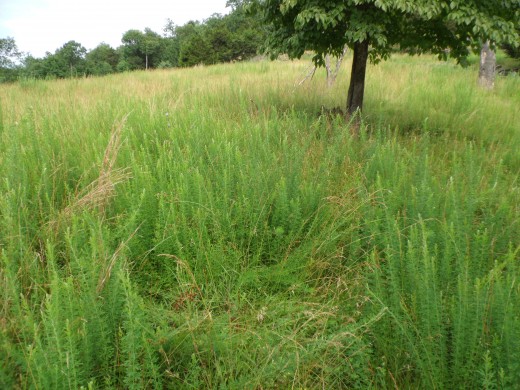
Lespedeza
Lespedeza, a warm season legume, produces high protein forage for goats during hot dry weather when cool season forages are dormant. Goats love it and will kill it if allowed to graze it without restrictions. There are two types of lespedeza commonly found in pastures of northern Arkansas, Serecia lespedeza and Korean lespedeza. Serecia lespedeza is a perennial that is dormant in winter but regrows from the roots in spring. Korean lespedeza is an annual which dies in autumn. It comes up from seed in spring. In northern Arkansas most varieties of Korean lespedeza will reseed themselves if not grazed too heavily. Serecia grows much taller (three to four feet) than Korean (four to eight inches.) Cattle do not like lespedeza as well as goats do. Both types of lespedeza are commonly found growing in cattle pastures, but they are very difficult to establish and maintain in goat pastures.
Five to fifteen years ago we over seeded all of our pastures with fifteen to twenty pounds of Korean lespedeza seed, per acre, each spring (about April first.) We got a good stand each year. The goats would not graze the Korean lespedeza heavily until the hop clover died in mid-June. The lespedeza produced extra protein for our goats in July and August when clovers were dormant. I know some producers who fed the lespedeza seed to their goats, letting them disperse it in their droppings. Back then Korean lespedeza seed was very inexpensive, about 50 cents per pound. Today it cost $5.00 per pound. We can no longer afford to seed it every year. The goats kept it grazed short enough so it would not reseed itself. The goats had usually killed it out by early September, but by then the cool season clovers would start to grow, and the acorns would begin to fall, and the goats would have plenty of high quality forage.
We have never been able to keep serecia lespedeza in any of our goat pastures. Auburn University has developed a new variety of serecia lespedeza called AU Grazer. AU grazer is more tolerant of heavy grazing than common serecia. In 2013, after having sold most of our goats, we set aside four acres of established fescue that we over seeded with fifteen pounds of Korean and 30 pounds of AU grazer serecia lespedeza seed per acre. We will not graze this field until the serecia is well established and the Korean has produced seed. We broadcasted the seed about April first without trying to prepare a seed bed. We got a very good stand of Korean lespedeza shortly after it was seeded, but no serecia came up as of mid-August. A few serecia plants started to appear in late August (single plants, ten to twenty feet apart.) We had gotten good rains during April, May, and the first half of June. This is normal for this area. From mid-June to mid-July we got no rain, but from mid-July to mid-August we got rain every day averaging an inch per day. This is very unusual for this time of the year because this is normally our driest month.
Two other meat goat producers in our area seeded AU grazer the same year that we did. Darlene Cullen, near Compton, Arkansas, broadcasted her AU Grazer seed without preparing a seed bed and did not get any serecia plants until late August. James McPherson, near Western Grove, Arkansas, planted in a good seed bed and got a very good stand shortly after planting. His serecia was about twelve inches tall when we had seen it on July 8th. Nancy Edgerly, Silver Hill Farms, near St Joe, Arkansas, had seeded serecia lespedeza in the past. She said it took one to two years to get a good stand after it had been planted. Many pastures in our area are too steep and rocky to be able to prepare a seed bed.
In 2014 the acreage we seeded to serecia lespedeza in 2013 had a very good stand of serecia by early fall. We had good rainfall through the spring and summer of 2014. Some plants came up in early spring and additional plants came up throughout the summer. The previous winter was very cold for our area, with lots of freezing and thawing and snow. These factors, along with the fact that the area was trampled by goats grazing the fescue during the winter, helped bury the seeds and crack the shells on hard seeds.
The acreage planted to Korean lespedeza in 2013 produced a good stand of Korean lespedeza in 2014. This could have come from seed produced by plants that grew in 2013, or from hard seed in the seed planted in 2013, or from both.
We plan to graze the four acres of fescue, which were over-seeded with lespedeza, only in winter until the serecia is well established. After the lespedeza is established we will only graze it lightly in the summer, allowing the fescue and the serecia lespedeza to stock pile for winter grazing. Serecia lespedeza seeds cling to the dormant plants in winter providing feed for goats and wildlife (deer, turkeys, quail, and song birds.) Hopefully the goats and wildlife will spread lespedeza seed to other areas in their droppings.
Serecia Lespedeza is a good legume to use for hay production. AU Grazer would be the best variety to use because it has finer stems and can tolerate frequent mowing. In the 1960’s we were able to buy serecia lespedeza hay. Our dairy goats milked better on it than on alfalfa hay.
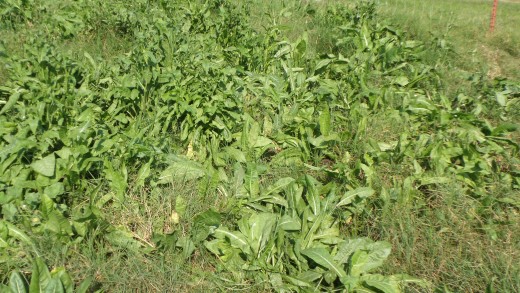
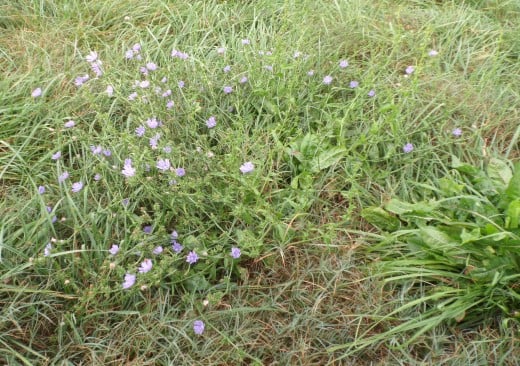
Forage Chicory
Forage chicory is a high yielding, perennial herb with broad, lettuce like leaves that grow from a crown. It can provide high quality forage during hot, dry weather when other forages are poor in quality.
Research done in New Zealand and in the United States, shows that chicory helps control internal parasites in goats and sheep. Chicory was first introduced into the United States in the late 1700s. It has since become a common roadside weed across most of the country. Chicory root has been used as a coffee substitute, and it is still used as a coffee additive in some areas. Wild chicory produces low forage yields.
Forage chicory has been used in agriculture for more than 300 years. It originated in Central Europe, but most of the recent breeding for improved forage production has been done in New Zealand. Forage chicory is neither a grass nor a legume. It is related to the dandelion. Its deep, thick taproot makes it drought resistant and able to do well in sandy soils. Chicory is known for its ability to handle grazing pressure. Chicory is very high in digestibility, low in fiber, and high in protein. It can provide over 30% crude protein on fertile soil. Its digestibility and protein values are greater than those of alfalfa. It also contains high levels of minerals that are essential for animal health. The high amounts of Magnesium in chicory will aid in control of grass tetany in animals. Chicory is a nitrogen loving plant and will benefit from nitrogen fixed by legumes such as clover, alfalfa, and lespedeza. It can provide high quality forage during hot dry weather when other forages are poor in quality.
Grazing management can be extremely important with chicory. In spring and summer, chicory grows vigorously and will attempt to produce flower stems in late spring and early summer. Management practices should not allow the flower stems to exceed a height of six to 10 inches. Grazing or mowing to a two to three inch stubble height can be used to achieve this. This will reduce the amount of stem bolting (rapid stem growth), and maintain the forage quality. Once bolting has occurred, the production potential of plants is reduced for the remainder of the grazing season or until the stems are mowed. Controlled grazing or mowing can sustain a productive chicory stand for up to seven years.
Chicory can be seeded at a rate of 4 to 5 pounds of seed per acre with good seed bed preparation. We use higher seeding rates (12 to 15 pound of seed per acre) when broad casting seed without any seed bed preparation. Much of our land is too rocky and steep to prepare a seed bed.
In the United States, until recently, forage chicory seed was very expensive and was sold only in very small packaging units (less than five pounds) for deer food plots. Two of the new varieties of forage chicory (Oasis and Six Point) can now be purchased in twenty five and fifty pound units at more reasonable prices. Both Oasis and Six Point brands of forage chicory have been bred for greatly improved disease resistance, which significantly increases survival under grazing. They also break winter dormancy earlier, resulting in a longer growing season, to provide high quality feed for a longer season. Oasis has higher levels of sesquiterpene lactones than other forage chicories. Limited research indicates that these compounds, together with small quantities of condensed tannins, may contribute to the gastrointestinal parasite control in goats and sheep. These compounds may also have negative effects on palatability and digestibility. They will also produce off flavors in milk produced by dairy cattle grazing chicory. The Choice variety of forage chicory has lower levels of sequiterpine lactones than any of other chicory variety. It is used for dairy cattle in New Zealand. It is only available in five pound units for deer plots in the United States. It is marketed by Pennington seed as Rackmaster Choice Chicory Seed.
